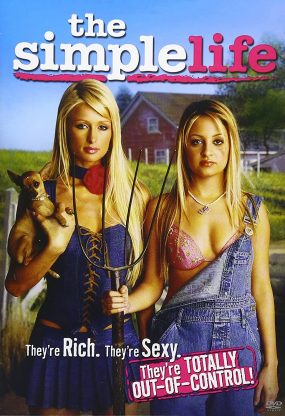
After nearly 20 years in the public eye, Hilton Hotel heiress and socialite Paris Hilton, 39, has finally revealed a taste of what goes on in her seemingly glamorous life in the YouTube documentary, “The Real Story of Paris Hilton.”
The documentary starts off with a quote by journalist Barbara Walters that sums up a main point of the film: “Paris Hilton is a new breed of celebrity, famous for being famous.”
Her height of fame was mostly during the early to mid-2000s, when she graced the covers of tabloids almost daily and starred in her own reality T.V. show. “The Simple Life” followed Paris Hilton and former best friend Nicole Richie, the adoptive daughter of rockstar Lionel Richie. It consisted of the duo traveling to different parts of the U.S. to work random jobs while they were portrayed as Beverly Hills rich girls. Nonetheless, the show coined now-iconic catchphrases and mottos.

In many interview clips shown in the documentary film, Paris Hilton is told that it seems she has grown up from her previous media-perceived “ditzy rich socialite” persona, to a now “serious businesswoman.” But the expressions on Hilton’s face implied that she has been in control of her image all along. Even with the 2010 cocaine possession charge and her “The Simple Life” character, Hilton said most of her public image is a persona, right down to the faux high, nasal voice, which sounds naturally deeper when she speaks regularly. Aside from her affiliation with her grandfather’s hotel chain, she has created a real estate project in her own name and continues to grow her brand, boasting 19 product lines which have earned almost $3 billion in sales.
The documentary features beautiful shots of Paris Hilton’s home and follows her in video diary-styled confessions. She prefaces with shots of childhood memorabilia, pictures of her and her family and speaks about how she was so lucky to grow up so privileged — yet there was a lot of pressure for her to live up to the legacy laid out by her family.
“It was hard to just totally be myself,” she said from her grandfather’s living room.
Hilton characterizes her childhood-self as a “free-spirit.” She said she was nicknamed ‘Star’ by her father. Though her grandmother, mother and aunts were all child actresses and models, Hilton’s mother “wanted something different for [Paris].”
Hilton has had a notable effect on the media industry since her rise to fame. According to Sheeraz Hasan, CEO of Fame by Sheeraz, he was able to build “the foundation of one of the biggest paparazzi companies in the world on the back of Paris Hilton. In the early 2000s, a photograph of her could have been sold to tabloids for about fifty-thousand dollars to a million dollars.”
“All the things that people are doing today on social media, the first one, was Paris Hilton,” Hasan said.
Hilton said people describe her as the “original influencer,” but she feels conflicted about the statement. She said she feels she has created a “monster.”
The turning point in her life was after her parents raised concern about her partying and presence in tabloid articles. Hilton was sent to an outdoor wilderness boot camp. She said a group she attempted to escape with was beaten in front of everyone when they were caught.
Hilton said she escaped a multitude of these camps, labeled emotional growth schools. She says these experiences “completely isolated her from her family and created trust issues within all the relationships [she] has had.”
During the interview, Hilton’s mother, Kathy Hilton, seemed to have no idea what the interviewer means when they say “when Paris was in solitary confinement.” She asked, “in Utah?”
The story begins and sounds much like the plot of a movie. With her parents’ knowledge, Paris Hilton was taken from her room unexpectedly then transported to Provo Canyon— a boarding school that supposedly focuses on the mental wellness and academics of their students. However, according to Paris Hilton, the school was anything but. At the Provo Canyon School in Utah, Paris Hilton says she endured her worst nightmare.
“You’re sitting on a chair staring at a wall all day long getting yelled at or hit,” she said.
Students were given pills to make them dazed and inattentive, and by refusing to take her own pills, Paris Hilton was sentenced to solitary confinement — which she compares to the 1975 film, “One Flew Over the Cuckoo’s Nest.” Paris Hilton was at the school for eleven months, and claims that her motivation to build her own success stems from not wanting to ever have to depend on her parents again.
In the last thirty minutes of the documentary, the focus is the aftermath of Paris Hilton’s time at the Provo Canyon School, and how the experience has affected Paris Hilton and her fellow-former classmates. The school has multiple abuse allegations against them, and the fight is still on as many victims have come forward to speak about their traumatic experiences. Movements like Breaking Code Silence have spawned to expose injustices of the troubled teen industry.
After leaving the Provo Canyon School, Paris Hilton met and worked with David LaChapelle, a world renowned photographer. Paris credits LaChapelle for that photoshoot, marking it a pivotal moment which launched her career into stardom. The photoshoot was published in Vanity Fair, and the rest was history.
Twenty years is a pretty long time to maintain an image, but Paris Hilton’s “party girl” character is her brand. She crafted and worked for her success tenaciously. Just as there have been countless parodies of her persona, like the blockbuster film “White Chicks” by the Wayans brothers, or characters like London Tipton from “The Suite Life of Zack & Cody,” there is no denying that Paris Hilton is a pop culture icon who has made the careers of countless people and changed the principles of fame altogether.

















